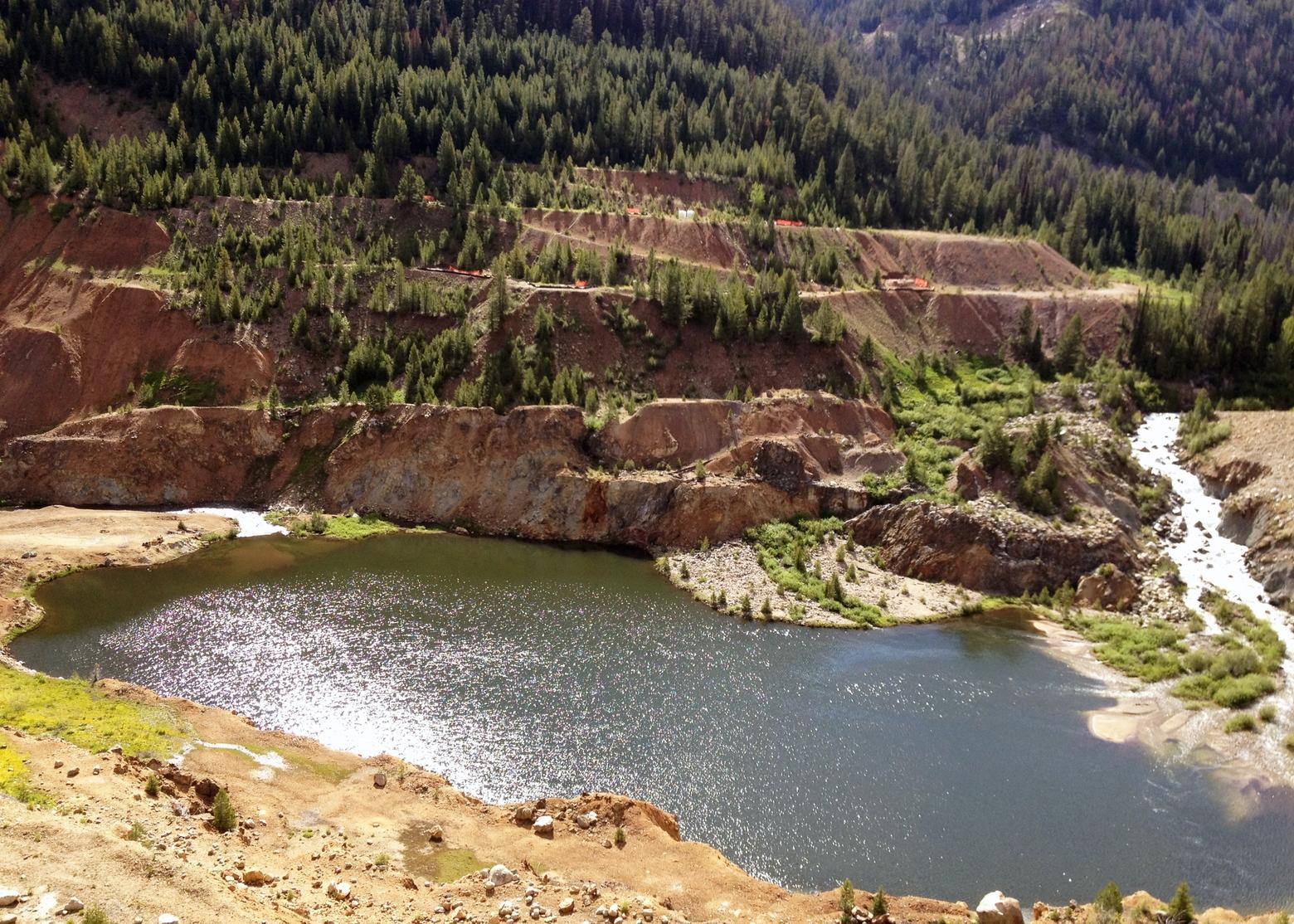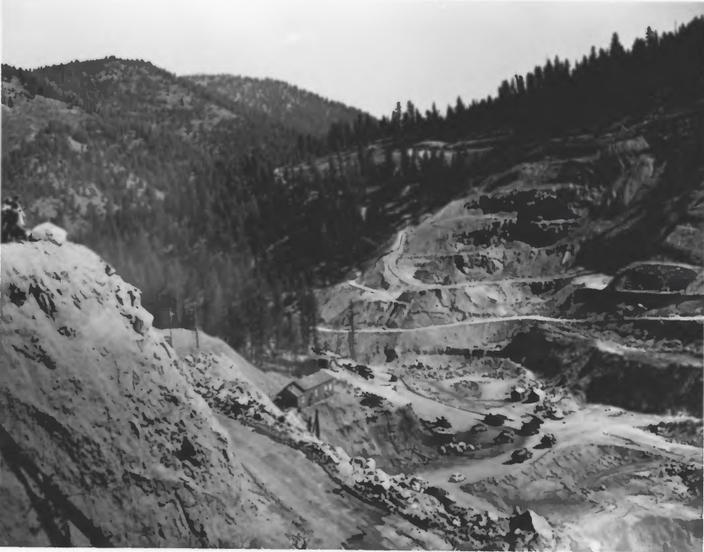Back to StoriesIdaho DEQ Presses Pause on Proposed Stibnite Gold Mine
Nelson added the agency is weighing the adjustments. “We are still evaluating these potential changes, so I’m not able to provide specifics at this time regarding what has changed and what that may mean specifically for the 401 water quality certification.”
April 9, 2025
Idaho DEQ Presses Pause on Proposed Stibnite Gold MineAgency requires mining company to revise water quality plan related to gold mine that would process 120 million tons of tailings over 15 years
UPDATE: This article has been updated to include new information from the DEQ related to the Final Environmental Impact Statement. The language has also been revised below to recognize the distinction between a state-issued water quality 401 certification and a federally issued water quality permit.
by Madison Dapcevich
The Idaho Department of Environmental Quality has filed a motion to pause legal proceedings on the proposed Stibnite Gold Project to revise a water quality 401 certification issued in May 2024.
Court documents cite DEQ’s need to “address new information and changes to the project,” including new regulatory developments and project commitments, notably the proposed long-term treatment of runoff associated with extraction methods. The agency says it needs more time to modify Army Corps of Engineers permits for the project to be in line with the Environmental Protection Agency’s Clean Water Act.
Perpetua Resources’ proposed mine encompasses approximately 3,500 acres located 45 air miles east of McCall, Idaho, at the headwaters of the South Fork Salmon River, according to the mining site’s filing on the Federal Permitting Dashboard.
DEQ’s motion came after conservation groups voiced concern over potential mercury, arsenic and antimony pollution at the mine and its potential to contaminate the Salmon River watershed. In June 2024, the Idaho Conservation League, Idaho Rivers United, Save the South Fork Salmon, and Earthworks filed the legal challenge by appealing the water quality certification, arguing that the certification “failed to consider water quality impacts” from mine pollution and lacked socioeconomic justification.
Though DEQ issued the water quality certification in May 2024, the U.S. Forest Service only recently approved the mine plan in January.
In February, local and national conservation groups announced their intent to bring civil action against the Forest Service, U.S. Fish and Wildlife Service, and National Marine Fisheries Service. The groups claim the home of the Nez Perce Tribe is under threat after federal agencies approved the open-pit, cyanide-leach gold mine that plaintiffs say would compromise wildlife, human and habitat health.
“From the start, we were concerned that this certification had been issued prior to the Stibnite Gold Mine receiving the final approval from the Forest Service and the required National Marine Fisheries Service’s Biological Opinion,” said Will Tiedemann, Conservation Associate at the Idaho Conservation League. “It is imperative that a project as consequential as the Stibnite Gold Mine fully comply with environmental law.”
An estimated 120 million tons of tailings will be produced by the proposed Stibnite Gold Mine over 15 years, the plan said, amounting to between 18,000 and 26,000 tons daily.
Adam McMahon, cyanidation program manager with Idaho DEQ, said the motion is specific to the department’s water quality certification of the Clean Water Act under Section 404. The EPA defines Section 404 as establishing “a program to regulate the discharge of dredged or fill material into waters of the United States, including wetlands."
"In other words," Section 404 continues, companies "must first show that steps have been taken to avoid impacts to wetlands, streams and other aquatic resources; that potential impacts have been minimized; and that compensation will be provided for all remaining unavoidable impacts."
“DEQ is requesting that the Army Corps of Engineers approve modifications to DEQ’s certification, which are being made based on new information in the Final Environmental Impact Statement for the Stibnite Gold Project,” McMahon said in an email to Mountain Journal.
Mary Ann Nelson, Idaho DEQ surface and wastewater division administrator, said the Forest Service published a final environmental impact statement approximately five months after DEQ finalized its certification of the project last year.
“DEQ relied on the draft EIS for evaluating potential water quality impacts from the project,” Nelson said in an email. This, along with a biological opinion published by the National Oceanographic and Atmospheric Administration, “resulted in some proposed changes to the proposed plan of operation which impacts how [DEQ will] evaluate the project to ensure compliance with Idaho’s water quality standards.”
Nelson added the agency is weighing the adjustments. “We are still evaluating these potential changes, so I’m not able to provide specifics at this time regarding what has changed and what that may mean specifically for the 401 water quality certification.”
As part of its mine plan, Perpetua Resources also requested the construction of a cyanidation facility, which went into effect on March 31.
Gold extraction typically requires one of two types of cyanide leaching, both of which use a cyanide solution over large amounts of crushed ore spread to dissolve the sediment and rock, or ore, in which gold and other metals are encased.
According to the plan, the Stibnite ore processing facility would be “designed to separate gold, silver, and antimony.” As part of the refining process, ore is crushed and ground up before being processed using cyanide leaching. After processing, tailings or runoff from extraction treatment are slated to be transported via a pipeline for permanent storage to be defined in a future certification modification.
An estimated 120 million tons of tailings will be produced over 15 years, the plan said, amounting to between 18,000 and 26,000 tons daily. Tailings will contain residual concentrations of cyanide and metals, including arsenic and antimony, that require a specially constructed tailings storage facility encompassing 423 acres.
DEQ plans to issue the following steps within 30 days of its March 25 motion, which would include a revised certification addressing current shortcomings and allowing Perpetua Resources to provide new information available since the original application was submitted. This timeframe also allows for public comment and hearing.
In addition to the water quality 401 certification, Perpetua Resources must also receive approval from the Forest Service on additional revisions to the plan, as well as accept reclamation cost estimates and review financial assurances, according to a press release published by the Idaho Conservation League.
If approved, Stibnite would be the fourth-largest gold operation in the U.S. by grade, and the only domestic source of mined antimony. Stibnite is a soft mineral containing sulfur and antimony, a native metal used for “technological and industrial purposes,” including liquid metal batteries and brake parts for cars.
__________________________________________________________________________________________________
Mountain Journal is a nonprofit, public-interest journalism organization dedicated to covering the wildlife and wild lands of Greater Yellowstone. We take pride in our work, yet to keep bold, independent journalism free, we need your support. Please donate here. Thank you.
Related Stories
August 6, 2024
Yellowstone Bison Plan Looks to Balance Interests
While
conservation groups have largely praised the new plan to govern bison
populations within Yellowstone, Montana’s governor and its ag community are
concerned about...
January 27, 2025
Grizzly Bear ESA Status in Question as FWS Cancels Public Meetings
The U.S. Fish and Wildlife Service pulls out of all four meetings intended to explain its decision to retain grizzlies’ threatened...
February 25, 2025
Grizzlies: Double Vision
With the Endangered Species Act comment period ending March 17, states and advocates are at odds over the future of grizzly...





